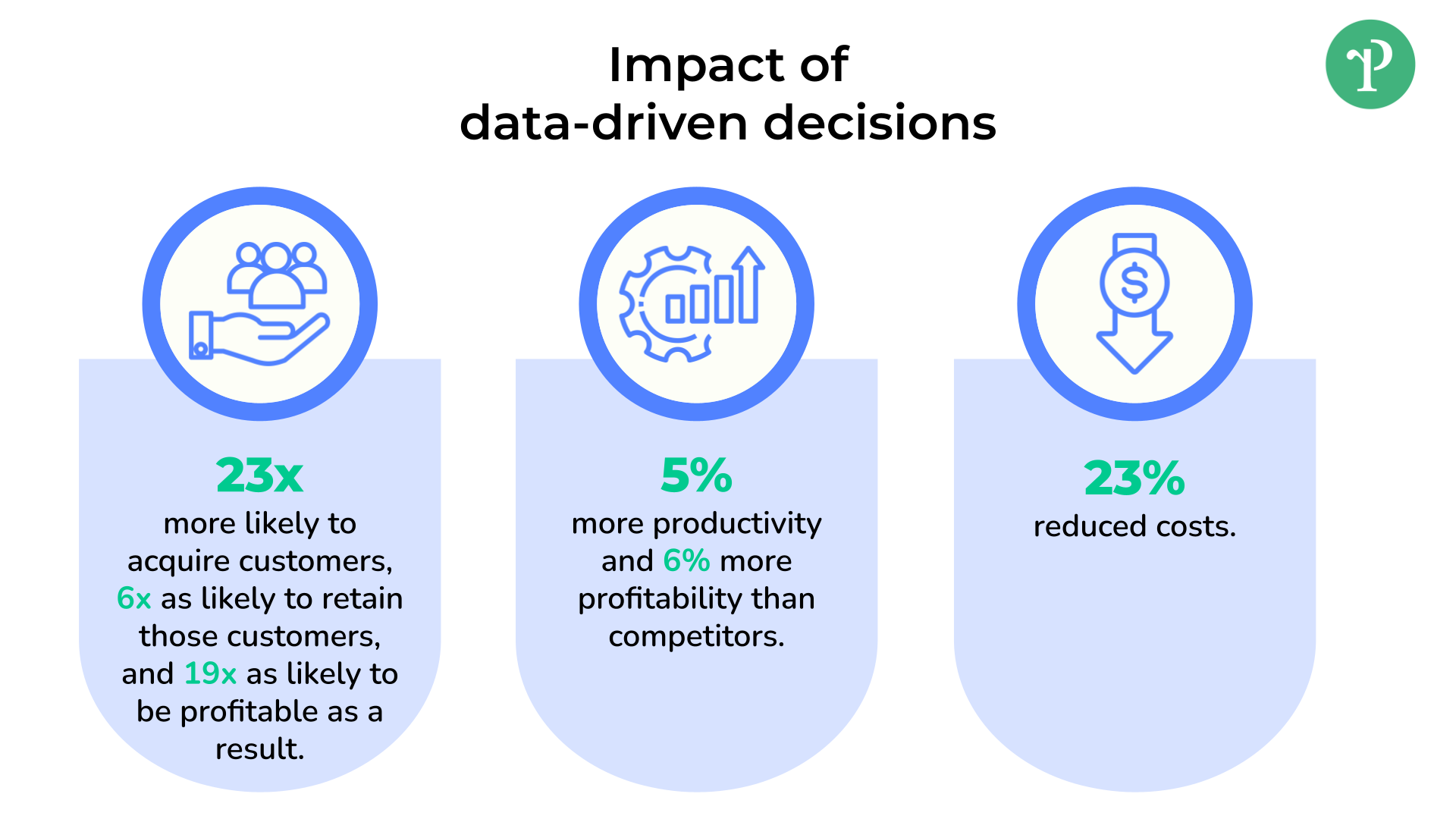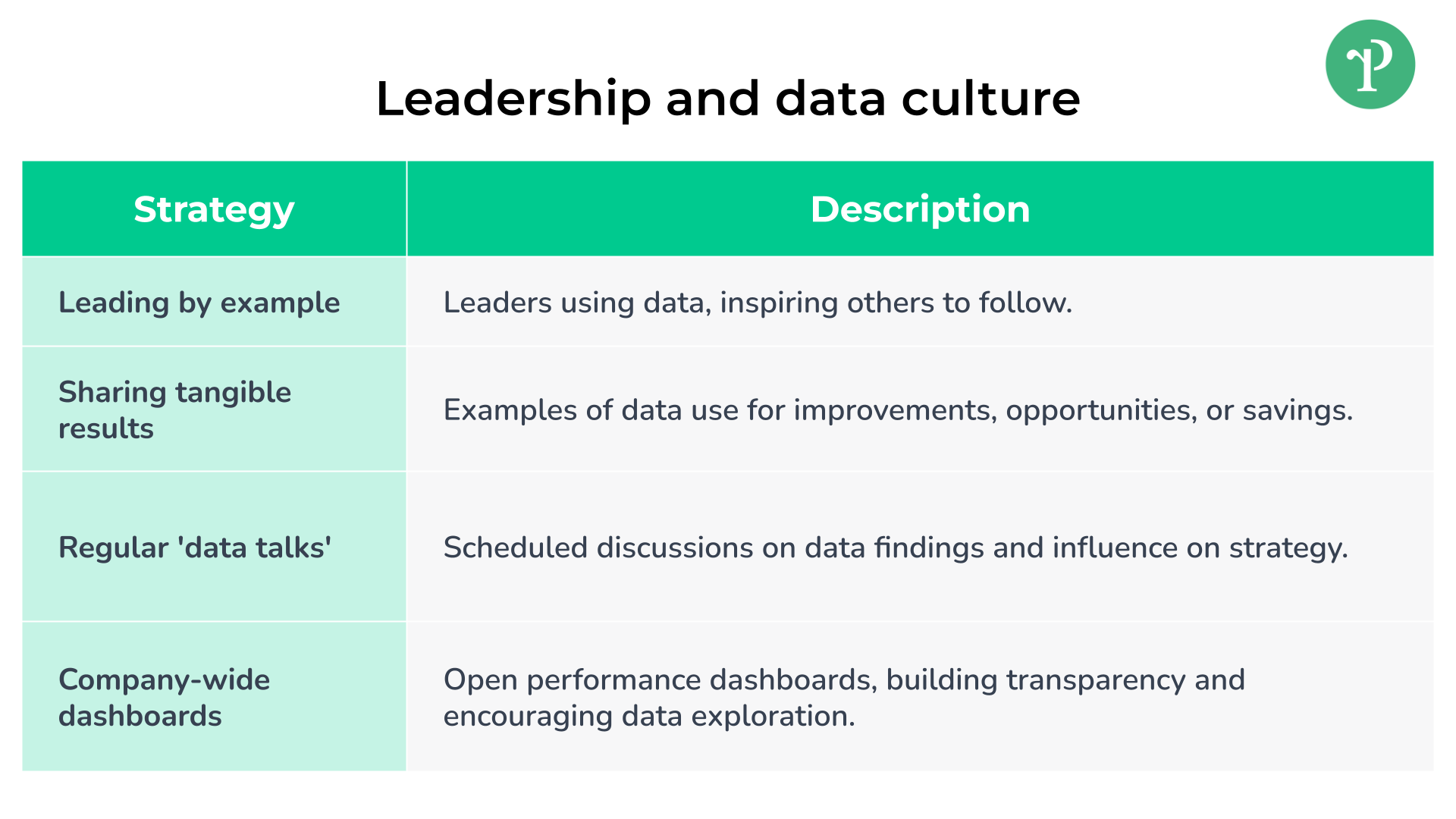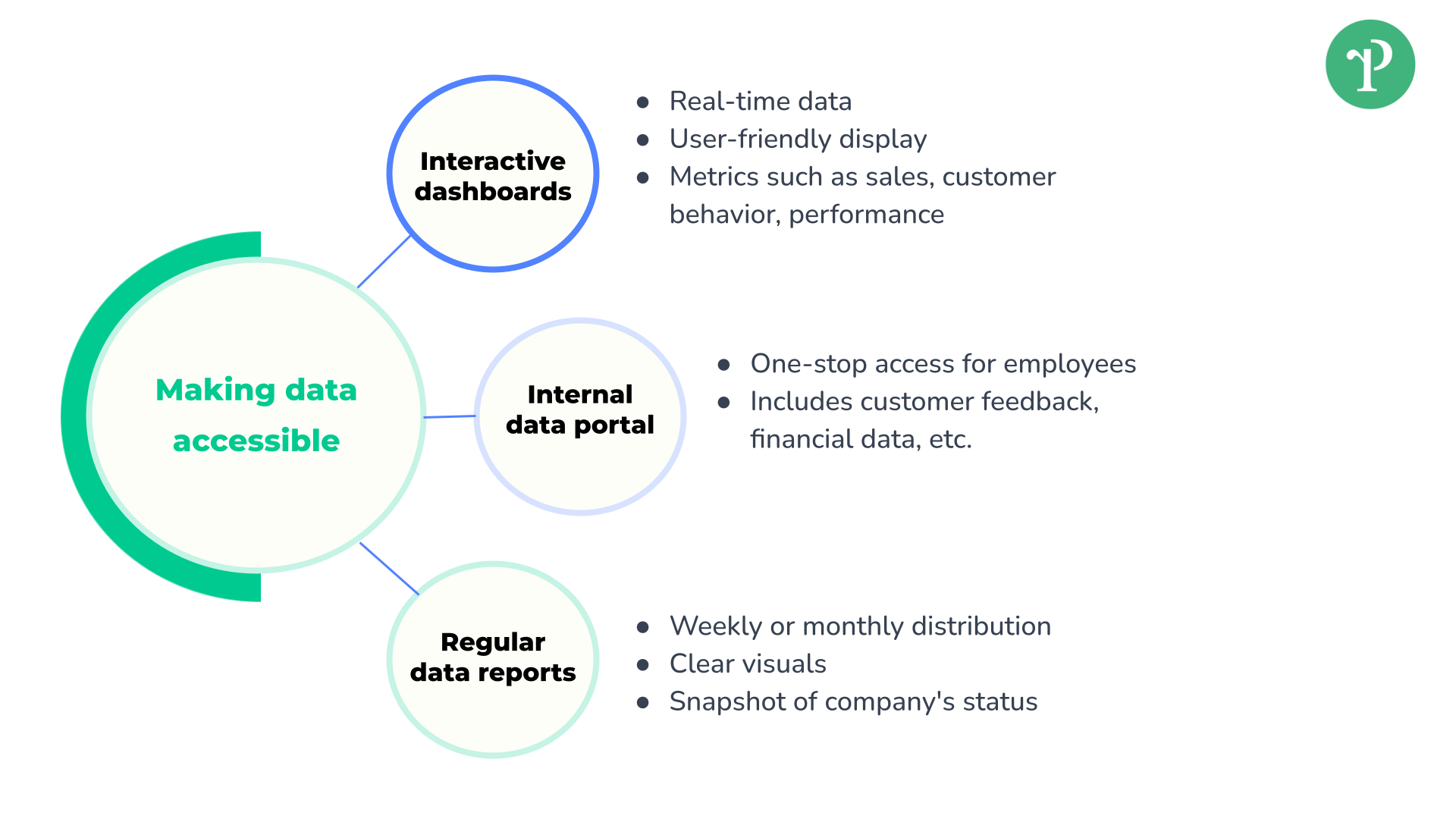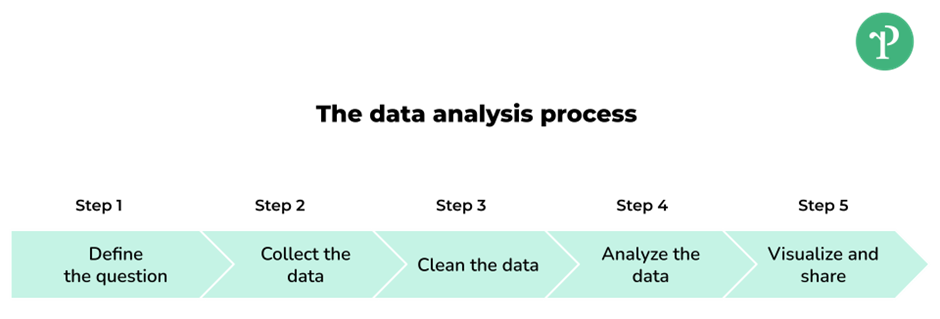What does it mean to be ‘data-driven’?
Being data-driven isn’t just about gathering a bunch of information and looking at it once in a while.
It’s about creating an environment where everyone makes decisions based on what the data is telling them, not just on what they feel or what they’ve always done.
This way of doing things helps make smarter decisions, makes work smoother and faster, and in the end, helps the business to grow.
The impact of data-driven decisions

The impact of data-driven decisions is aplenty. Among them are:
Data-driven organizations are 23 times more likely to acquire customers, six times as likely to retain those customers, and 19 times as likely to be profitable as a result.
Companies that are data-driven have 5% more productivity and 6% more profitability than their competitors.
Data-driven decision-making can reduce costs by up to 23%.
People in a data-driven culture
Data-driven decisions aren’t just for the data scientists and data analysts in a company.
Everyone in the organization, from executives to frontline workers, needs to get what data is all about and why it’s important for the decisions they make. This understanding, known as data literacy, allows everyone to make data-driven decisions.
The following strategies can help an organization’s workforce adopt a data-driven approach to work.
Leadership and data culture
Leading by example is the best way to set a data-driven culture. When the people at the top start using data, others will follow.
Leaders could share how they used customer data to improve a product or service, showing tangible results. They might show in a meeting how analyzing sales data helped them identify a new market opportunity. Or they could share a story of how data analysis led to cost savings in a certain department.
Another way could be regular ‘data talks’ where leaders share interesting findings from recent data analysis or discuss how data is influencing the company’s strategy. This could be part of monthly team meetings or separate regular events.

Finally, leaders can use company-wide performance dashboards that are openly accessible. This demonstrates that decisions are based on data, and everyone can see the same data leaders use. This not only builds transparency but also encourages employees to explore data on their own.
Training and development
Training and development are about giving everyone the skills to question, explore and make sense of data, no matter their role. Training will teach employees how to:
Gather data from various data sources
Interpret and understand what the data is telling them
Identify and focus on key metrics relevant to their work
Use data visualization tools to turn complex data into easy-to-understand visuals
Understand the importance of clean, quality data
Know what could go wrong if the data isn’t accurate
Use data to make informed decisions in their daily work
Communication
Talking about data, again and again, helps it stick in people’s minds.
For example, companies can share insights on how analyzing customer data led to changes in a product that significantly boosted sales. They might explain how a deep dive into operational data helped streamline a process, saving time and resources.
Companies could also share examples of how data analysis uncovered trends in customer behavior, leading to a successful marketing strategy. Or, they could illustrate how analyzing financial data guided strategic investments that drove company growth.
Sharing these real-life examples not only shows the power of data but also demonstrates how data-driven decisions directly contribute to the company’s success. It’s a great way to bring data to life and keep reminding everyone how valuable it is.
Making data accessible
Making data easy to get at means more people will use it. This might mean setting up systems that let people see data in simple, understandable ways. For example, companies could use interactive dashboards that display real-time data in a user-friendly manner. These dashboards can display things like sales numbers, customer behavior, or performance metrics.

Another example is to have an internal data portal. This is a one-stop shop where employees can find all the data they need. It could have everything from customer feedback to financial data, all in one place.
Lastly, you could consider regular data reports. These are documents or emails sent out to everyone on a regular basis, say every week or month. These reports give everyone a snapshot of what’s happening in the company, using clear and simple visuals to make the data easy to understand.
Process: putting steps in place for data
The word “process” here refers to the methods or steps we follow when we work with data. This includes how we collect, clean, analyze, and use data.
These steps need to be clear and the same for everyone to make sure all are on the same page.
Clear steps with data
The first step is to have clear processes in place for handling data. It’s like giving your employees a recipe to follow. This could include steps like gathering raw data from various sources, checking the data quality, analyzing the data, and finally, using the data to draw conclusions and make informed decisions.
Uniform data handling
The next step is to make sure everyone handles data in the same way. This could mean that we all use the same tools for certain tasks or follow the same steps when we collect or analyze data.
Having this consistency helps avoid confusion and ensures we’re all on the same page.

Keep processes up to date
Data processes need a refresh from time to time. This means looking at the tools you’re using, adding new places where you get data, and making sure you’re following the latest rules about data.
For example, if there’s a new social media site where customers are leaving lots of feedback, you might need to add this site to your process of collecting customer feedback.
Or if there’s a new law about data privacy, you’ll need to change how you handle customer data to follow this law.
Technology: the engine of a data-driven culture
The technology that powers data-driven decision-making is the foundation of a data-driven culture. The right tools will make it easier for everyone to access, analyze and use data.
Data-driven tools
The first step is to make sure you have the right tools. These could include analytical tools, data visualization software, and reporting dashboards. It’s important to choose the right ones for your business as these are what power successful data-driven decisions.
Automated processes
The next step is automation. Automating data processes helps to save time and resources, allowing teams to focus on more important tasks. It also helps avoid mistakes and ensures consistency in how data is handled.
Data integration
Data integration is another key factor here. This means connecting different systems with each other for easy access to data. For example, you might want to integrate your customer feedback system with your sales data to get a better understanding of how customers feel about certain products.
Artificial intelligence and machine learning
Finally, exploring the possibilities of artificial intelligence (AI) and machine learning can help you uncover powerful insights in data. These technologies can be used to uncover patterns or trends that might not be obvious when humans analyze data.
The professionals who can help you build a data-driven culture
Creating a data-driven culture is a team effort that involves individuals with various skills and expertise.
Let’s take a closer look at some key players who can play a significant role in helping you kickstart your journey toward becoming data-driven:
Data scientists
Data scientists are experts in analyzing data. They find valuable insights from complex data sets using advanced techniques like machine learning and statistics. Hire data scientists to predict future trends and give useful recommendations based on data analysis. Data scientists also set up systems to collect and handle data effectively.
Data analysts
Data analysts look closely at data to find patterns and trends. They create easy-to-understand reports and dashboards for different teams in the company. Data analysts provide insights that support important decisions. They also make sure the data they use is accurate and reliable.
Data engineers
Data engineers build and maintain the systems that handle data. They create data pipelines, databases, and other tools to handle data efficiently. Their work ensures that data flows smoothly and can be used effectively by data analysts and scientists.
Business analysts
Business analysts connect data to the company’s goals. They understand how the business works and use data to answer important questions. They work with data experts to translate business needs into data terms and make sure data insights are practical for the business.
Data analytics trainers
Data analytics trainers teach everyone in the company how to work with data. They run training sessions and workshops to make sure everyone understands data and can use it in their jobs. Data literacy trainers help create a culture where everyone is comfortable with data.
Change management specialists
When a company becomes data-driven, there are changes to adapt to. Change management specialists help with this process. They explain the benefits of data-driven practices, handle any resistance, and make sure everyone embraces the new data-driven way of working.
Conclusion
A data-driven culture allows businesses to harness the power of data, turning it into actionable insights that propel the business forward. With the right people, the right processes, and the right technology, any business can thrive in the age of data.












